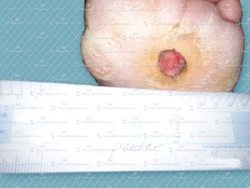Epidemiology and Etiology of Diabetic Foot Ulcers
Diabetic foot problems, including ulcerations, infections, and gangrene, are the most common grounds for hospitalization among diabetic patients. In particular, foot ulceration affects between 15 and 25 percent of patients with diabetes mellitus during their lifetime. 1Diabetic foot ulcers are notoriously difficult to heal, and may take weeks or months to close, even if treated promptly and intensively. Unfortunately, a significant number of diabetic foot ulcers may never heal satisfactorily, despite current best practice. Of those diabetic foot patients who do ultimately achieve wound closure, it is thought that around 70 percent will have at least one further recurrent lesion within 5 years of treatment.1
The development of diabetic foot disease can be ascribed to three principal pathologies; diabetic peripheral neuropathy, peripheral arterial disease, and infection. These factors can present individually or in any combination, although neuropathy is considered to be the most important pathology.2 Diabetic neuropathy can affect the sensory, motor and autonomic functions, and increases the risk of ulceration seven-fold. The lack of pain and sensation in the foot caused by sensory neuropathy makes the foot highly vulnerable to repetitive trauma, which may go unnoticed until ulceration becomes visible. At this stage, treatment is more problematic.
It is not difficult to see why diabetic ulcers are one of the most feared complications of diabetes.2 More than 1 million people with diabetes require amputation each year, leading to significant morbidity, mortality, and obvious psychological trauma. The healthcare costs of performing a large number of amputations with all the aftercare that is required is also substantial.3,4 It is therefore essential that steps are taken to reduce the risk of a diabetic foot ulcer forming. Next week we will look at some of the preventative measures available to both patients and healthcare providers to help avoid the crisis of a diabetic foot ulcer.
Learn More With Our Wound Care Education Options
Interested in learning more about wound care and certification? Browse through our wound care certification courses for information on our comprehensive range of education options to suit healthcare professionals across the full spectrum of qualifications and experience.
References
- Dorresteijn JAN, Valk GD. Patient education for preventing diabetic foot ulceration. Diabetes Metab Res Rev 2012; 28 (Suppl 1): 101-106
- Khanolkar MP, Bain SC, Stephens JW. The diabetic foot. Q J Med 2008; 101: 685-695.
- Abad C, Safdar N. From ulcer to infection: an update on clinical practice and adjunctive treatments of diabetic foot ulcers. Curr Infect Dis Rep 2012; 14(5): 540–550.
- Bakker K, Schaper NC. The development of global consensus guidelines on the management and prevention of the diabetic foot 2011. Diabetes Metab Res Rev 2012; 28 (Suppl 1): 116-118


This blog was… how do you say it? Relevant!!
Finally I’ve found something which helped me. Kudos!
Thank you for visiting WoundEducators.com!
Thanks for finally writing about >Epidemiology and Etiology of Diabetic Foot Ulcers | WoundEducators.com |
Online Wound Care Certification Courses <Liked it!